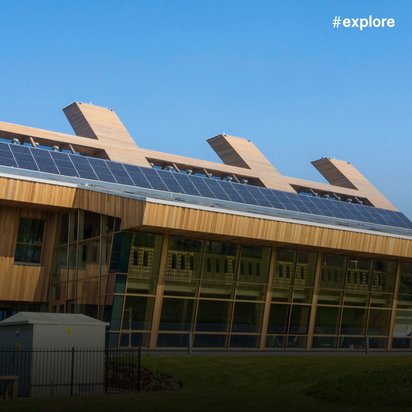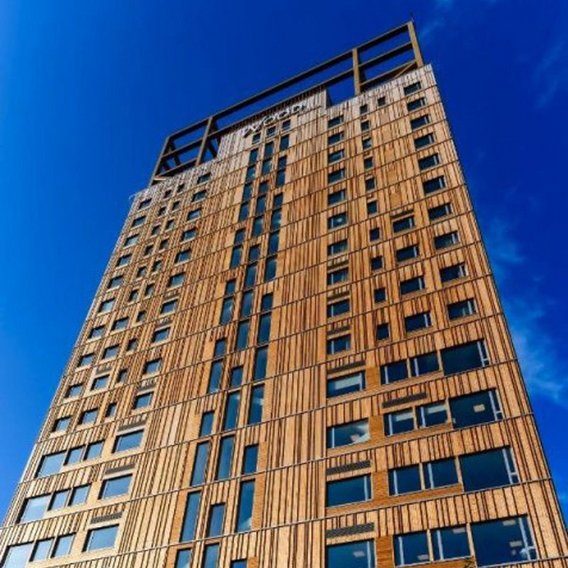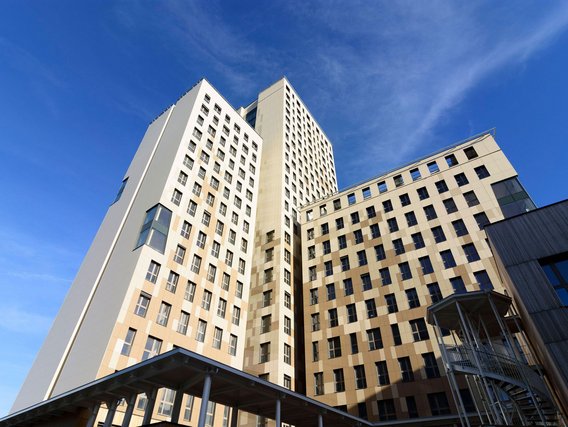architecture
Wood, Clay, and Straw for a Better Climate
Wood, Clay, and Straw for a Better Climate: Read now on #explore how construction can become more environmentally friendly.

architecture
Wood, Clay, and Straw for a Better Climate: Read now on #explore how construction can become more environmentally friendly.

August 27, 2020
A roof over one’s head is, as we all know, a basic necessity. But the construction and operation of buildings are currently extremely harmful to the environment. The group Architects for Future wants to change that. This independent alliance of architects and civil engineers is committed to encouraging ecological rethinking in the building industry. We spoke with civil engineer Tore Waldhausen about why renovation is better than new construction and how materials like wood and clay can benefit the climate—both in our homes and globally.
#explore: Mr. Waldhausen, what makes building so environmentally harmful in the first place?
Tore Waldhausen: Building involves enormous resource consumption. Globally, 50 percent of energy and 50 percent of all extracted raw materials are used for the construction and operation of buildings. On top of that, the sealing of land surfaces by buildings, roads, and parking lots causes further problems. While a lot has already been done in terms of saving energy during the operation of buildings, many people are unaware of how much energy is consumed just in constructing them and producing the materials.
What are the key goals and demands of “Architects for Future”?
One of our main demands is to critically reconsider demolitions. A lot of buildings are torn down simply because it's more economical. From an ecological standpoint, however, it makes much more sense to reuse existing structures, so we don’t have to invest additional energy into new materials. We also advocate for the use of healthy, climate-positive building materials.
Another crucial point is designing for circularity. We need to select and develop materials and products in a way that allows them to be reused in closed cycles—so they don’t become waste in the first place. This connects to our next concern: avoiding downcycling. Although building materials are often recycled today, their quality and functionality usually degrade in the process. It’s officially called recycling, but in reality, these materials lose value over time.
We also want to tap into so-called urban mines, meaning we prioritize the use of existing materials and infrastructure. And importantly, we aim to preserve and create biodiversity—like green roofs and façades in urban areas. Fundamentally, we also want to promote an open society through architecture. Since we spend 90% of our lives indoors, the way we build has a major impact on how we live together as humans.
What could a circular system in the construction industry look like in practice?
We take strong inspiration from the cradle-to-cradle principle. In construction, this means thinking in terms of two cycles: a biological and a technical one. A good example of the biological cycle is wood. When used correctly, wood has a long lifespan. If it does need to be removed, it can be repurposed in many ways: as furniture, then as wood fiber insulation, and finally as fuel. If untreated, it can even be composted and returned to nature as nutrients for forests or agriculture.
In the technical cycle, we need to design materials so they too can re-enter the system. Take steel, for example—if it's installed in a way that allows it to be separated from other materials, it can either be reused directly or melted down to produce new steel. Of course, this requires methods for producing or recycling steel using only renewable energy.

Why do we even need alternatives to cement and concrete?
Cement and concrete are incredibly practical building materials with a wide range of applications. The major problem: their production releases enormous amounts of CO₂. Cement production accounts for four to eight percent of global CO₂ emissions – more than the entire aviation industry. Climate-friendly building materials offer enormous potential for reducing emissions. In certain applications, such as tunnel construction, concrete currently cannot be adequately replaced. Here, we need to continue researching alternatives. But especially in residential construction, where structural requirements are lower, there are excellent substitutes like wood, clay, and straw which, when used correctly, also benefit the health of residents.
What advantages do wood, clay, and straw offer for the environment and for residents?
Wood is a natural CO₂ store – and every kilogram of stored CO₂ is currently worth its weight in gold. Wood also has good thermal insulation properties and is breathable, which promotes a healthy indoor climate. The same goes for clay, which helps regulate temperature and humidity. It's simply very pleasant to spend time in a space built from or clad with clay. Compared to wood, clay is even more of a regional product, meaning short transport distances. Straw, in turn, offers excellent insulation properties and is a natural, untreated raw material. It’s simply compressed and can be delivered directly to construction sites by local farmers. Straw walls can be easily plastered with clay. Together, they create a wonderfully comfortable indoor climate.
When people hear “straw house,” they might think of the fairy tale of the Three Little Pigs, where the big bad wolf quickly blows the straw house down. How stable and fire-resistant are such buildings really?
Even just the clay plaster provides basic fire protection and also deters pests from eating the straw. Building a straw house in the city is still a bit more challenging. Fire safety regulations require a building to withstand fire for sixty to ninety minutes without collapsing. Ensuring this with straw is challenging, but achievable. Of course, a straw house must meet the same structural requirements as any other house. In Germany, these houses are typically built with a timber frame structure, with straw compressed into place purely as insulation. Technically, using straw as a load-bearing material – for example in a duplex – would be possible, but it’s not yet permitted under current building codes. However, there is currently movement toward adapting these regulations.

Are such materials even suitable for all types of buildings and regions?
Yes, absolutely. In some cases, their use is even more appropriate from a building physics perspective. The structure of buildings made from these materials is more flexible than those made of steel or concrete, which actually makes them better suited to conditions in earthquake-prone regions. Even bridges for heavy-duty traffic are now being built from wood — for example, in the Netherlands. In Norway, there is a wooden high-rise that stands 85 meters tall, and Japan is planning a wooden skyscraper that will reach 350 meters. Projects like these attract attention and can help promote the widespread use of wood as a construction material. That’s definitely a positive development.
However, to meet the growing demand for housing in cities, we don’t necessarily need to build new high-rises. Depending on the structure of existing buildings, residential homes can be expanded upward by one or two stories — something commonly done in Vienna. This approach creates new living space without sealing additional land. Such concepts can also be implemented using alternative building materials, and we should pursue these strategies much more consistently in our own country.
Why is environmentally friendly construction often simply too expensive for investors? How can that be changed?
Investors and developers often think too short-term. Yet ecological building is always also high-quality building. It may require somewhat higher initial investments, but in return, it is more durable and retains its value better. Such a building can be passed down to the next generation in 50 years or sold without a loss in value—because the materials used circulate in closed loops and therefore don’t depreciate over time. So, building ecologically can already be worthwhile today—for the environment, for the residents, and also for the investors.
What political decisions need to be made to promote sustainable construction?
The most important measure would be to increase the cost of CO₂ emissions generated during material production and the construction process. That would make renovation more economical than demolition and new construction. At the same time, it would increase demand for and availability of renewable building materials. To further encourage renovation, one idea could be to require permit procedures for demolition similar to those for new construction. These could include mandatory deconstruction plans. The goal should be to make manufacturers more responsible for the disposal of their products.
What role does sustainable building play in education and training?
Unfortunately, still far too little! The German Sustainable Building Council has made some progress in recent years, creating various modules and seminars for architectural education. But the offerings at universities and in vocational training remain limited. As a result, many students turn to our regional groups to learn more about circular construction using materials like clay or straw. There are initial signs of change to better integrate climate-friendly building into university curricula—but there's still a lot of room for improvement. That’s why we at Architects for Future are working to ensure that this student demand is actually met.
How does Architects for Future aim to advance sustainability in the construction sector?
From my point of view, the concept of “sustainability” falls a bit short—it suggests that the goal is merely to reduce our negative environmental footprint. Instead, our buildings could also leave a positive footprint, benefiting both people and the planet. At Architects for Future, we aim to raise awareness about the possibilities of climate-friendly construction through public outreach and education. At the same time, we’re actively involved in politics by contributing our expertise to municipal building projects, for example.
“With its green façade, the city hall building in Venlo, Netherlands, measurably purifies the air within a 500-meter radius.”
Tore Waldhausen, spokesperson for Architects for Future
Which projects have already implemented such climate-friendly construction in an exemplary way?
Every person who tries to build differently and better is making an important contribution! One particularly outstanding example in my view is the city hall in Venlo, Netherlands. With its green façade, it measurably improves air quality within a 500-meter radius. It also has a positive effect on employee health—people working there have fewer sick days than others in comparable jobs. In addition, many Cradle-to-Cradle-certified materials were used in the building. What’s especially important is that the initiators placed great value on bringing everyone involved in the construction process together from the beginning, in order to jointly create a building with a positive impact on the region. In conventional projects, people often work against each other instead. The Venlo city hall is a great example of how building can be done better when everyone works toward a common goal.
What does the ideal sustainable building of the future look like to you?
Houses like trees, cities like forests—that’s how I’d describe my vision. What if our homes could store CO₂ like trees? What if they improved air quality and were powered entirely by renewable energy? What if our buildings used local resources that circulate in closed loops and provided a habitat for many different people and living beings? These principles can—and should—increasingly become reality in our buildings.
This is an article from #explore. #explore is a digital journey of discovery into a world that is rapidly changing. Increasing connectivity, innovative technologies, and all-encompassing digitalization are creating new things and turning the familiar upside down. However, this also brings dangers and risks: #explore shows a safe path through the connected world.